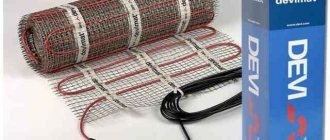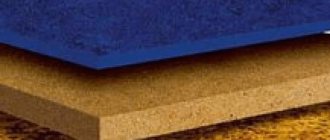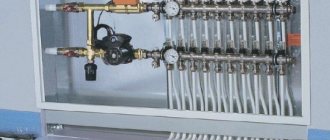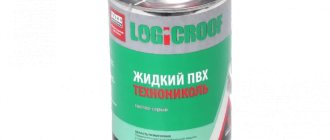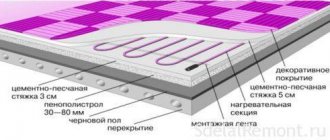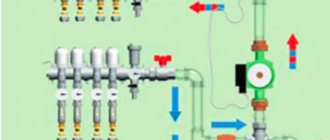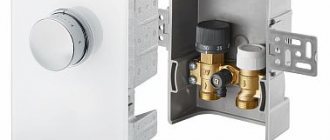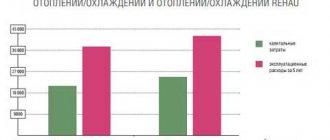Preparing a concrete floor for laying linoleum
Concrete flooring is considered the best option for laying linoleum on it.
This is due to the fact that it is quite easy to level and achieve almost perfect smoothness. The first thing to do is clear the surface for the upcoming actions. Furniture is removed from the premises, old baseboards are removed, and trash is swept away. The easiest way to prepare the floor for laying linoleum is to use a screed made from a solution of sand and cement. For the solution, river sand is taken, which should be sifted. The solution is mixed for 1 hour. – cement + 2.5-3 hours. sand. (Mark of solution 50-100 kg/cm².)
The easiest way to prepare the floor for laying linoleum is to use a screed made from a solution of sand and cement
Sometimes cement-casein mastic (1/4) is used, for example, when it is planned to glue linoleum to the same composition.
After removing all excess, dust and dirt, the prepared surface should be thoroughly moistened with water. To maximize the result, it is recommended to use beacons, which are slats made of wood or metal. The lighthouses are placed at a distance of one and a half meters, while maintaining their same horizontal level. All slats are supported from below in increments of 0.5 m. This is done so that the beacons do not bend. Then the space between the slats is poured and carefully leveled with a small spoon. The thickness of the screed is affected by the topography of the concrete floor.
Filling the floor using beacons
After laying the mortar, leveling is done manually with trowels. Then the surface is rubbed. It should be leveled until there are no holes and good smoothness. Experienced craftsmen do not recommend strengthening screeds by ironing with pure cement. A surface that is too smooth reduces the quality of adhesion between the floor and linoleum, which in this case will not be durable.
The finished surface is constantly kept moist for 5 days to prevent it from cracking. To do this, water it 1-3 times a day. As a result of this technique, the floor dries out gradually and evenly.
cement m300
Flooded screed
Sometimes you only need to slightly repair the base. In this case, everything unnecessary is removed from the old screed: dust, dirt, etc. Then the base is checked with a 2-meter bar. All problem areas are marked around the perimeter with chalk.
Checking the base with a 2-meter bar
The solution for cement-sand screed is the same - 1/3. For repairs you will need brushes, spatulas, trowels and trowels. After the defects have been removed, these areas are dried. All debris is swept away and polished, usually done using special bars. Finally, you can sand it with sandpaper or pumice. The quality of work will be much better if you grind using a grinding machine.
The quality of work will be much better if you grind using a grinding machine.
In order to fill small irregularities and voids, the surface is also puttied. This is most often done in non-residential premises; at home you can do without it.
Putty
Types of heated floors and their scope
According to many people, heated floors come in one type, but this is not true. Today there are a lot of them and each of them is adapted to certain conditions. But that's not all, warm floors also differ in the method of installation. Heated floors can be water or electric.
Water floor
The water floor is heated using a coolant, it can be water or a special liquid. This coolant can be heated using a home heating system.
Water heated floor
By and large, a water heated floor is a system of pipes laid under the floor covering. It is best to use a metal-plastic pipe for these purposes, which must be solid, since any connection will sooner or later turn into a leak, and when it is under the floor it will cause a lot of problems, so it is better that the pipe is solid and not made of pieces.
Such a system will be cheaper in cost than an electric one, since, by and large, you only need a pipe. In terms of installation complexity, such a system is not inferior to an electric one. Very often, this type of underfloor heating can replace the heating system and the house will be warm, although when I first heard this, it seemed nonsense to me, but it turns out that it is not.
If we consider laying a heated floor under linoleum, I would refuse such an idea, this is my opinion, and I do not impose it on anyone, but below I will describe how the installation can be done.
Electric heated floor
Electric heated floors have several varieties. Most often, this type is used for a concrete base, but there are also types for wooden coverings. Actually, the system itself doesn’t care where it is laid, but not every surface can be laid with any type.
Electric heated floor
The first type is a heating cable. The heating cable, in turn, is also divided into 2 types: simple and self-regulating. The difference between them is that in a simple one, the heating is controlled by a special thermostat. Actually, this type is more suitable for heated floors.
But the self-regulating wire is designed more interestingly, although not complicated. It contains two conductive wires and they are separated from each other by a special heating matrix, which is capable of changing resistance depending on temperature. So it turns out that the colder the surface it comes into contact with, the more it heats up.
Such a cable will not heat up in the air. Most often used to protect water pipes from freezing. There is a type of underfloor heating where a simple heating wire is laid on a fiberglass mesh. When laying, such a mat is rolled out and filled with screed. Well, okay, let's move directly to the species that interests us.
The most suitable heated floor for linoleum on a wooden floor is an infrared heating system. It lies in the fact that such a system emits infrared rays that heat objects, not air, thereby reducing heat loss, because heat is not wasted.
infrared film
This system consists of carbon plates connected to each other by a copper busbar and laminated with a special film. They look like a roll about 50 centimeters wide, very thin, like 2-3 sheets of paper. This type of heating is ideal for linoleum. Sold both by the meter and in whole pieces designed for a specific area.
You can cut the infrared floor along special cutting lines drawn by the manufacturer; these lines go every 20-30 centimeters. The kit includes special terminals for connecting to electricity, as well as bitumen-based insulating material. I will tell you about the installation technology below.
Operating principle of infrared floor
The combination of linoleum made of flammable polymers and electric heated floors at first glance seems unacceptable. However, the risk of short circuit and fire in the infrared film heating system is reduced by manufacturers to almost zero. You just need to follow the instructions when assembling it, doing everything according to the rules. At the same time, today the linoleum coating itself can be found with fireproof characteristics “G1” + “B1”.
The operation of an infrared floor is based on the emission of infrared waves by carbon heating elements. These rays first heat the surfaces of various objects in the room. And from the furniture and walls, heat spreads throughout the room, creating comfortable conditions in it.
Necessary layers for laying heated floors
Among the advantages of film heated floors are:
Electricity is converted into infrared rays by thermal film with an efficiency of 90–100%. And unlike a water heated floor, the film analogue cannot cause a flood, because there is no water in it.
It is allowed to lay linoleum, laminate, tiles or carpet on top of it. Moreover, installing such underfloor heating in a room of up to 20 m2 on a prepared base requires only a couple of hours.
The disadvantages of this heating system are the following:
- high price of IR film;
- high electricity bills;
- dependence of heating on the presence of voltage in the electrical network.
With a small active area of a heating floor powered by electricity, its power consumption is within the range of 1–3 kW. A regular outlet will be enough for it to work. But with higher consumption for thermal film, you will have to lay an additional cable from the electrical panel and install an appropriate RCD there, which costs money.
Warm floor design
And whether the required kilowatts are available is a big question. Apartments and private houses are designed for a very specific energy consumption, which cannot be exceeded. Before purchasing infrared linoleum floors, you must first clarify the very possibility of connecting them to an existing network. If there is no capacity, then you will have to look for another option for arranging heating.
Why should you choose heated floors?
The classic use of heating systems involves the presence of radiators, which distribute their heat when heated, and then maintain warmth in the room. As a rule, batteries are mounted at a certain height in the area where windows or load-bearing walls are located. The air in the room gradually warms up.
Following physical laws, warm air masses rapidly rise upward. As a result, the top of the room becomes warm and the floor becomes cold. Thus, a large amount of energy is wasted inefficiently.
Scheme of operation of heating systems of various types. The advantage of heated floors is manifested in the uniform distribution of heated air throughout the entire volume of the room
When using underfloor heating technology, heated air masses accumulate at the bottom, and slightly cooled ones accumulate in the upper part, under the ceiling. This option of temperature distribution with a difference of up to 2-4ºС is the most optimal and comfortable for humans.
Choosing the right brand of linoleum
There is an opinion that linoleum is a completely synthetic floor covering that, when heated, releases chemicals hazardous to health, such as phenol.
Linoleum is also reproached for its poor ability to withstand heat. When exposed to high temperatures, the coating may noticeably deform.
Marmoleum is a type of linoleum made from natural materials. This coating looks great and goes well with heated floors.
Finally, the material was originally created not to transfer heat, but to protect from the cold penetrating from below. All this is true, but only partly. Linoleum is easy to install and moderate in cost, which is why it remains an extremely popular floor covering.
Modern technologies and developments have allowed manufacturers to create new types of linoleum. Among them there are those that perfectly transfer heat, tolerate moderate heat without compromising their appearance and do not emit any dangerous fumes.
There are five main types of linoleum:
- alkyd or griftal;
- nitrocellulose, also known as colloxylin;
- relin or rubber;
- vinyl, or rather PVC;
- natural, known as marmoleum.
Without going into details of the production technology, we can immediately note that the first three options are categorically not suitable for use with heated floors. All of them react poorly to heat, and Relin is not at all suitable for use in residential areas.
The most popular version of linoleum is its PVC version. This coating is very diverse in design and thickness, relatively safe, and has a pleasantly moderate price. After installation, vinyl covering almost always emits a not particularly pleasant characteristic odor, which dissipates over time.
However, PVC linoleum is not dangerous; it is suitable for premises where people live. When purchasing, it is recommended to study the labeling of the material; there should be a mark on the packaging stating that this coating is intended for installation on underfloor heating systems.
For example, ordinary linoleum can be equipped with an additional layer of heat-insulating material, which is completely unnecessary over a heated floor.
Not all linoleum is suitable for laying over underfloor heating systems. The markings on the flooring packaging will help you choose the right material (+)
Natural linoleum, also known as marmoleum, is a cutting-edge word in the flooring market. The material contains exclusively natural ingredients, such as crushed cork bark, pine resin and linseed oil, powdered limestone and natural dyes.
Of course, when heated, such material cannot emit any harmful substances, only natural fumes. Marmoleum is sensitive to strong heat, so the issue of choosing a temperature regime for such a coating must be approached very responsibly. However, this is also true for vinyl materials.
Marmoleum can only be blamed for its substantial price, but the high wear resistance and safety of the material fully justify such costs. Marmoleum does not change color over time and also effectively resists fire.
When choosing linoleum for a warm floor, you need to pay attention to the thickness of the material. A coating that is too thin will expose all the unevenness of the base; an excessively thick material will reduce the efficiency of heating the room
Pros and cons of electric heated floors under linoleum
The advantages of linoleum are a large selection, low price, simple and quick installation.
But linoleum also has disadvantages when laid on a warm floor. It does not have very good thermal conductivity, which reduces the heat transfer of the heating element, and there are also restrictions on the heating temperature. Therefore, if linoleum is not selected correctly, the following can happen:
- Color changes
- Material surface deformation
- Phenol vapor
But in general it is combined with TP, especially if it has signs marking heated floors.
Marking linoleum for use under heated floors
Natural linoleum, or marmoleum in other words, is also well suited for laying on TP. Of the other types of “unnatural” linoleum, you need to choose by type, thickness, class. So that the flooring gives pleasure and lasts for many years.
Please note there is an article on the topic “Which linoleum is better to choose for a heated floor?” Read more at the link.
Subtleties of arranging a water-type heated floor
To install such a system, you need to lay a new floor on top of the wooden base with special grooves into which pipes will subsequently be installed. There is another option that involves installing pipes in special polystyrene foam mats covered with heat exchangers.
We will look at the first case in more detail.
Water heated floors can be installed without using a cement screed. The figure shows two of the possible schemes for arranging such a system.
Preliminary work
We install logs on top of the wooden base, on which the floor will subsequently be laid. They should be placed at a distance of about 60 cm from each other. At the same time, be sure to ensure that the height of the logs is the same. Otherwise, the base under the linoleum will be skewed.
Between the joists we lay a layer of hydro and vapor barrier under the insulation. Experts recommend using only special materials for these purposes. The use of conventional film will inevitably lead to the appearance of condensation, which will accumulate in the insulation and destroy it.
We lay a layer of insulation on top of the waterproofing. This can be mineral wool with a density of 40 kg/m3 or other material with similar properties. We lay the insulation evenly, straightening it between the joists. After everything is laid, cover it with steam and waterproofing film.
We lay the floorboard so that a groove is formed between the planks for installing the pipe. Its size must correspond to the diameter of the part. For example, for a pipe with a diameter of 16 mm, a groove of 20x20mm will be sufficient. At the ends of the base you need to make round grooves, the so-called loops.
They are designed to rotate the heating main.
For laying pipes, you can make special slots in the flooring boards. The grooves must be of sufficient size to accommodate pipes.
Pipe installation
Place a strip of foil on top of each longitudinal groove. Place the pipe directly on it and wrap the element in foil. We fasten its edges to the board with a stapler. Then we fasten the pipe to the floor with small metal plates across the groove. This is necessary so that the part does not slip out of its place.
The entire pipe is laid in this way
It is important that there are no joints within one contour. You need to prepare enough pipe to cover the entire circuit.
In this case, the system pressure will not be enough to ensure the movement of the coolant and the circuit will “lock up”. For a 16 mm pipe, it is not advisable to exceed a length of 70-80 m, and for a 20 mm pipe - 110 m. If the estimated length is greater than the maximum limit, you will have to split the system into two or more circuits.
Connection to the heating system
At the last stage, we connect the warm floor to the heating system. This operation can be performed in different ways: using a manifold system, using a mixing unit or with manual adjustment. The most suitable option is chosen by the system owner.
After the connection is made, the pipeline is pressure tested. This is a mandatory procedure that guarantees against unpleasant surprises in the form of leaks and swollen floor coverings. We cover the heated water floor with sheets of plywood, thus preparing the base for installation of the finishing coating.
Pipes laid in grooves are wrapped in foil and secured with small strips of metal. This way they won't be able to slip out of the groove.
Installation of a warm water floor
To install a heated floor, you must purchase the following materials:
- polyethylene film, the thickness of which is 150 microns;
- polystyrene plate with a thickness of more than 20 mm (with “bobs”);
- reinforcing mesh;
- damper tape;
- inlet and outlet manifolds;
- pipe for heated floors made of cross-linked polyethylene.
The schematic design of a warm water floor clearly shows that the pipe is located inside a concrete screed, so each circuit consists of a whole segment.
Installation of a warm water floor begins by ensuring waterproofing and thermal insulation of the concrete base, which must be smooth and clean. A polyethylene film is laid on the thoroughly leveled screed.
Adjacent panels are secured with construction tape. Polystyrene slabs with special elevations called “bobs” are laid on the film.
Lugs are needed to quickly secure the flexible pipe of a heated floor in the desired configuration.
The placement of a polyethylene or metal-plastic pipe for a water-heated floor on special mats with bosses. Additionally, the system is fixed with reinforcing mesh
The size of the pipe laying step is from 10 to 30 cm. The choice of laying step is influenced by the amount of heat loss in the room equipped with a heated floor. On average, it takes about 5 linear meters of polyethylene pipe per square meter of heated space.
A reinforcing mesh is laid on top of polystyrene slabs with a pipe fixed between the bosses, which is needed to strengthen the concrete screed in which the warm water floor system is hidden.
A damper tape is laid along the entire perimeter of the room along the walls, which can compensate for the thermal expansion of the cement screed. Then connect one end of the pipe to the inlet manifold, and the other to the outlet. The mixing unit is fixed in a manifold cabinet screwed to the wall of the room.
At this point, the installation of the pipe for the heated floor is considered complete. The screed is poured. Linoleum is not laid on the concrete screed itself, but on sheets of plywood. Other floor coverings can be placed without the use of plywood in accordance with the requirements of their installation technology.
The advantages of installing a heated floor system in a house are clearly presented in the diagram. Warm floors under linoleum are used as additional heating to the existing heating system
You can use a water heated floor as additional heating to a radiator system. If desired, a warm floor can completely replace it, acting as an independent supplier of heat in the house.
Water underfloor heating operates on any energy source: gas, liquid fuel, electricity. This does not require heating the coolant in the system to high temperatures. At the entrance to the circuit, the coolant temperature is 30-40 degrees.
The pressure in the water heating system starts from 2 atm. Due to this, it is possible to ensure energy savings and achieve gentle operation of system elements compared to other alternative types of heating.
During operation of the water heating system, no electromagnetic radiation is generated, the effects of which are harmful to human health. Since there are no detachable connections in the floor, the likelihood of a leak is zero.
The service life of the system is 50 years or more.
Which IR heated floor is preferable for linoleum
Manufacturers offer two types of IR heating systems. Each has its own advantages and disadvantages and when choosing a system you should make it based on your individual needs.
| Film floor | Rod floor |
| Safety and reliability of operation | Safety and reliability of operation |
| Both types work using IR radiation, the warranty period is 15 years. | Both types work using IR radiation, the warranty period is 15 years. |
| 1. Does not require preliminary work during installation; it is mounted on a flat concrete surface using the “dry installation” method. 2. Heats up when furniture is placed on an insulated floor. | 1. Laying in a screed made of concrete or tile mixture. 2. Does not overheat when covering work areas with furniture and household appliances. |
| Versatility | Versatility |
| Can be used to insulate floors, walls, ceilings and other flat surfaces | It is used only for floor insulation, including in rooms with high humidity. |
| Energy saving | Energy saving |
| Increased energy savings compared to alternative heating systems | Increased energy savings compared to alternative heating systems |
| Price | Price |
| A budget option. | High price. |
| Thermoregulation | Thermoregulation |
| A thermostat is required. | Independently lowering the temperature in heated areas of the home and lowering it near cold areas - window and door openings. |
Carbon rods
Heating elements in the form of carbon rods emit infrared waves when the temperature rises. The systems are produced in the form of mats.
We recommend: How to connect an electric boiler for underfloor heating?
Installation is carried out on a base made of concrete or self-leveling floor mixture. The coating must be prepared. Waterproofing, insulation, and a reflective foil screen are placed on it.
- The entire floor area is covered with mats. The rods can withstand high loads of furniture and household appliances.
- If it is necessary to rotate the mats, then the wire between the elements is cut and further installation is carried out.
- Strengthen the rods to the floor surface with tape.
- All conductors are connected in parallel and lead to the thermostat. This device controls the operation of the heating system.
- A temperature sensor is placed between the rods. It is placed in a corrugated tube and connected to the regulator.
The “warm floor” made of carbon rods under the linoleum is covered with a concrete screed no more than 5 cm deep. A thin underlay is strengthened on it and the linoleum is laid.
If the floor surface undergoes a high mechanical load, then it is recommended to lay gypsum fiber board sheets on the screed. If the floor covering is tile, then tile adhesive is applied to the carbon elements with a layer of 3-4 cm.
Installation stages
Warm floors under linoleum on a wooden floor are laid in several stages. They should be considered and studied in detail before installation.
- Determining the location for the thermostat, temperature sensor and heating element.
- Floor preparation and subsequent installation of heated floors. Laying thermal insulation. It is carried out together with fastening the film together. In addition, you need to mark the material so as to use its length as efficiently as possible. Pieces of infrared flooring should be placed as close to each other as possible (but without touching). This will ensure maximum even heating.
- Installing the terminal clamp. Insulation of copper busbars that were exposed during installation of the structure. At the same time, the silver contacts of the heated floor are insulated.
- Fixation of heating using mounting adhesive tape. Installation of temperature sensor and thermostat.
- Laying the connecting cable along the baseboard. You also need to hide the lead to the thermostat in a groove made in advance in the wall. Connecting devices to the thermostat.
- Connecting devices to the network with further testing of heating. When doing this, it is worth checking the degree of heating of each individual strip of infrared film.
When the verification work is completed, it is necessary to carry out the final installation of the system and secure it with mounting tape. Fiberboard is laid on top, and then linoleum, purchased earlier. The fiberboard layer is needed to ensure that there is no contact between the PVC coating and the carbon heater.
After this, you need to adjust the thermostat itself to the optimal temperature. As noted above, the recommended value is 26–27 degrees.
Carbon film
An underfloor heating system made of carbon film is installed on a flat wooden or concrete surface. The base must first be protected from condensation and from the downward propagation of infrared waves. Membrane waterproofing and foam with a reflective surface are intended for this purpose.
They use thermal film with a carbon mixture, which is applied in stripes or as a continuous coating. You can create a “warm floor” under linoleum with your own hands.
- The canvas is laid on the prepared surface. Strengthen with tape.
- Parallel connection of individual sections is carried out. The cable is routed to the control device.
- Electrical elements are controlled by a thermostat.
- A temperature sensor is placed on the floor, which detects temperature changes.
- The system operates from a 220 V network.
“Warm floor” under linoleum requires protection. When using soft cladding, sheets of plasterboard are laid on the thermal film. Choose a material with locks to make it easier to install the coating. Sheets must be insulated from condensation.
The carbon fiber sheet is covered with plastic film. Drywall is additionally treated with moisture-repellent impregnation. The floor is covered using a thin underlay, no more than 3 mm.
Suitable types of linoleum
According to popular belief, linoleum is a thin vinyl material that contains more chemical elements. But this is not true.
In total, today the construction market offers customers five varieties of this flooring:
- Natural. This type is an environmentally friendly material. It also has a huge service life and a high level of fire resistance.
- PVC floor covering. Most often, people buy this particular material because of its cheap cost. This type is not particularly suitable for heated floors. When the surface heats up, an unpleasant odor will appear in the room.
- Alkyd. This linoleum has a fabric base. Has excellent thermal insulation characteristics. However, there is a significant drawback - after a certain period of time, due to heating or mechanical influences, the product undergoes deformation.
- Nitrocellulose. It consists of one layer and has moisture-resistant characteristics. But there is also a minus - a low level of fire resistance.
- Rubber. It consists of two layers. The composition of this material includes bitumen, rubber, synthetics. Rubber linoleum is rarely used in residential buildings.
According to a brief description of all varieties of this flooring, not all are suitable for heated floors. The best option is the first type - natural. The use of vinyl linoleum (PVC) is allowed. Other types are not suitable for the heating system.
Let's take a closer look at the first two types.
Natural linoleum
If you can afford to buy it, then opt for it. This product contains only natural elements of nature, namely flax oil, pine resin, crushed cork, lime powder, and natural dyes. It follows from this that this variety, when heated, will not be able to release substances that could be harmful to human health.
This is the main advantage over other types, but not the last. Another distinctive feature is that the material is not deformable during heating or mechanical stress. "Marmoleum" has a high level of fire resistance. It can be exposed to direct sunlight, but natural linoleum will not lose its original appearance.
Linoleum PVC
Otherwise called vinyl linoleum. The natural look is not sold everywhere like vinyl flooring. Choose PVC if you are unable to find natural ones.
This type is divided into separate types:
- domestic;
- commercial,
- semi-commercial.
For residential premises it is recommended to use the last two types. Because they have a higher level of stability and a longer service life. Do not use a product that has a thermal insulating base, because it will serve as an obstacle to the penetration of heat into the room. Heating elements in this case will be useless.
The material must have a fabric base. Don't forget that the vinyl product is made of synthetics, so after the initial heating there may be an unpleasant odor. But after about a month it will disappear.
Might be interesting
Ultra-thin film heated floor
Ultra-thin film or, as it is also called, infrared heated floor differs from the types discussed above in that it has the smallest thickness, since it is a flexible polymer heat-resistant film inside of which there are thin heating elements - strips of carbon paste connected by busbars made of copper foil, according to to which voltage is supplied.
In addition to its smaller thickness, film heated flooring is distinguished by the fact that it can be laid under linoleum or other floor covering in a “dry” way, that is, without screed. This can significantly reduce installation time and reduce labor costs. The floor heats up quickly and more evenly. You can make such a warm floor with your own hands quite easily and quickly.
The disadvantages include the higher price of such a heating film element and the fact that it is susceptible to moisture. Therefore, it is not advisable to use it in rooms with high humidity, and in dry rooms it must be protected from accidental ingress of moisture through joints in linoleum panels, if any. To do this, it is enough to cover the film heating elements on top with a waterproofing material, for example, polyethylene film. Another disadvantage is that as a result of heavy objects falling and moving onto the linoleum, the film heater located underneath may be damaged.
Film electric heated floor under linoleum
Installation procedure for film heated floors
First, as in the first two cases, it is necessary to calculate the required thermal power of the floor, and therefore the area of the film element.
After this, it is necessary to prepare the subfloor and its thermal insulation. In principle, it is carried out in the same way as in previous cases: if the base has not been insulated before, then it is necessary to lay a 5-10 cm layer of insulation, preferably penoplex, and over it, for better heat transfer, foil or penofol. If the base was previously insulated, then a layer of foam insulation will be sufficient.
The film heating element must be cut into pieces of suitable size. The places where this can be done are usually indicated by the manufacturer with marks. You can make a cut between individual strips, but so as not to damage them. The incision sites are isolated with tape. The length of the strips should not be more than 8 m. The cut pieces of film are laid according to a previously drawn up pattern. It should be remembered that they cannot be overlapped. Having laid the strips of film on the floor, we mark the places for the grooves for the cables and the temperature sensor.
The copper parts of the contacts should be at the bottom and directed towards the location of the thermostat (thermostat). The number of regulators depends on the area of the heating surface of the heated floor at the rate of 1 regulator for every 10-15 m2.
We mount the temperature sensor (it is insulated and placed under the film) and connect it, as well as the film elements, to a thermostat mounted on one of the walls. Sheets of film are connected in parallel. We press special contact clamps onto the ends of the cables, which are then attached to the copper strips using pliers. The film strips are connected to the grounding wire using electrically conductive tape. The thermostat is connected to power and grounding, after which you can test the operation of the heated floor.
Connection diagram for film heated floor panels
If the system is working normally, then turn it off and lay the flooring on top, in our case, linoleum. If it consists of several panels, then it is better to lay a waterproofing film under it.
In order to avoid accidental mechanical damage to film heating elements during operation, a layer of plywood is often first laid on top of them, and linoleum is spread over it. True, in this case, plywood will slightly reduce heat transfer and reduce the efficiency of the heated floor.
Laying linoleum on a film heated floor on plywood
Choosing linoleum for heated floors
Traditional linoleum is a material made from synthetic resins. It can be laid on any surface, and it has different textures and colors. However, when exposed to temperatures above 250C, the material begins to warp, lose shape and, as a result, durability. In addition, this type of linoleum is a fire hazard, so its use for heated floors is unacceptable.
Linoleum for heated floors is usually indicated by the following icons:
Another flooring option is marmoleum. In essence, it is similar to linoleum, but natural wood flour and linseed oil are used for its production. Thanks to this, the material has the following features:
- fire resistance: the material does not burn or smoke;
- wear resistance: does not wear out, is resistant to dirt, service life up to 30 years;
- antibactericidal properties: microorganisms do not multiply on this type of coating;
- operation at temperatures up to 280C.
The last feature suggests that the material will interact perfectly with infrared heated floors.
The golden mean would be multilayer PVC linoleum, which is also suitable for heated floors. True, the environmental friendliness of this material is much lower than that of marmoleum.
If we talk about prices, the approximate cost is as follows: linoleum - from 150 rubles / sq.m., multilayer PVC material - from 400 rubles / sq.m., marmoleum from 800 rubles / sq.m. Knowing the approximate prices, you can purchase the material according to your financial capabilities.
Kinds
Warm floors can be used indoors as an addition to existing heating systems, or as a separate independent product. Today there are two types of heated floors - water and electric.
At the beginning of the last century, thanks to the invention of the water pump, the first type of heated floor appeared. The heat source was hot water, which circulated through copper pipes. The equipment was not cheap, so the system did not receive widespread use until the 1980s.
After replacing iron pipes with polymer ones, we managed to reduce the cost of the finished product. This led to increased demand, and warm water floors began to appear en masse in European homes.
A modern water heated floor is a heat-insulating layer with a metal mesh and aluminum foil, on which a tubular corrugated system is laid. Two devices are responsible for the temperature. Under the laminate there is a sensor, and on the outside there is a thermostat.
Water at a certain temperature circulates through the tubes due to the operation of the pump. It can be supplied from the riser - this is a good solution for bathrooms and kitchens, as well as from central heating - in all other cases. In exceptional cases, it is possible to operate the system without a pump.
A warm floor based on a hot water circulation system, despite its advantages - the affordable cost of the product and low cost of installation, also has its disadvantages:
- when pouring the screed it is easy to damage it;
- in city apartments there may be problems with neighbors, there is a possibility of flooding.
The resistive heating cable was patented about a century ago. The Norwegian company Nexans was the first, and it also holds the world record. Back in the late 30s of the last century, one of the first electric underfloor heating systems was installed in the city of Oslo. It worked without failure until the beginning of the millennium; after a major renovation of the premises, the system was replaced with a new one.
Over the past decades, the electric version of heated floors has developed in every possible way. Today its varieties are known - cable, film and rod.
The operating principle of a cable electric floor is based on wires made of special alloys. Experts have designed the wires in such a way that they convert energy into heat, and the thermostat is responsible for the temperature.
This system has a long service life and low energy consumption. One of the disadvantages is the high cost of installation. Cheap kits are more likely to generate electromagnetic radiation. High-quality underfloor heating is marked with ISO 14000 and KIMA symbols.
For film electric heated floors, the operating principle is based on a specially developed carbon film. Under the influence of electric current, its elements heat up, producing infrared rays and releasing anions. Carbon-based paste emits directly. It is applied either in straight or curved lines.
In expensive models, continuous application is practiced, which ensures heating of the entire working surface area. The temperature is set using a thermostat. Any adult can install such a rolled floor.
Rod (carbon) electric heated floors have appeared recently. But during its existence, it has established itself as a reliable and environmentally friendly building material. Korean scientists have come up with a system that runs on carbon rods. Mats with “intellectual filling” are sold directly in stores.
The thermomat has the following advantages:
- Durability. Its elements do not break under the weight of household appliances and large furniture. Self-regulating infrared heated floor reduces the possibility of local overheating.
- Compatible with all types of screeds. Its contacts do not deteriorate and the system does not fail.
- Moisture resistance. The rod floor can be installed in bathrooms, loggias and terraces.
- Environmental safety.
- Self-regulation of temperature allows you to control energy consumption. Energy-saving floors are installed not only in city apartments, but also in country houses. Even wealthy people are not ready to waste money.
Like any new product, economical carbon heated floors have a high cost. Thanks to this, scammers are also becoming more active, releasing counterfeit goods. You need to be very careful when purchasing.
The underfloor heating substrate must have low thermal conductivity. In this regard, polypropylene and extruded polystyrene foam are most often used as a base.
Types of quality linoleum
The rational choice of floor covering is the fundamental basis for the successful implementation of a heated floor project.
The building materials market is replete with a large quantity and variety of linoleum. Models with a high heat transfer rate are ideal for laying the product on the floor.
The finishing material should be selected based on the degree of toxicity of the raw material.
Particular attention should be paid to the composition and safety of the special coating:
- Vinyl. The product is formed on a PVC base, which gives it a beautiful design. But when heated strongly, the material becomes a source of an unpleasant and pungent odor.
- Relin. The basis for the production of such linoleum is bitumen, synthetic rubber and high-quality rubber. The front layer has problems with heating, which does not allow its use in living rooms and premises.
- Nitrocellulose (colloxylin). The material has a high level of moisture resistance, but is easy to burn.
- Glypthal (alkyd). Fabric-based flooring cannot withstand high temperatures, which leads to significant deformation.
- Marmoleum. The environmentally friendly material has high quality workmanship, which gives it fireproof and antistatic characteristics.
Professional builders agree that marmol or vinyl type linoleum is suitable for creating a water-heated floor. A more economical option is alkyd modifications with a special film coating.
An important factor is the ability of linoleum to conduct heat. If this indicator is low, then there is no point in using it. Beware of purchasing flooring made from jute, various felts and foamed PVC.
The floor surface under the linoleum should be level. Otherwise, unevenness will be visible through the thin coating.
Between the film heater and the relatively thin linoleum it is necessary to place a solid base, for example, plywood. By ignoring this recommendation, you will ensure that all flaws will be visible to the naked eye.
Fluid circuit
The floor-mounted liquid line system is universal. The circuit is laid on a concrete base, which is prepared accordingly. The pipeline is laid out on a reflective surface. Close it with a deep screed. It is also an element of underfloor heating.
We recommend: What myths exist about the dangers of heated floors?
The highway does not require additional protection. Any furniture and equipment is installed on the floor, and the finishing coating is made from both hard and soft materials. Before covering the screed with linoleum, it is necessary to lay the underlay. Be sure to withstand thermal conditions of no more than 28 0C.
Any underfloor heating system can be installed under the soft cladding. Laying a water-heated floor under linoleum is carried out according to the usual scheme.
Electric heating elements require additional protection in the form of a coating of cement fiber boards. Correctly choose the facing material. Linoleum on a thick fabric base is not suitable. It traps heat.
YouTube responded with an error: The request cannot be completed because you have exceeded your quota.
- Related Posts
- How to set up a programmable thermostat for heated floors?
- How are PEX pipes connected for heated floors?
- How to choose a boiler for underfloor heating?
- How to install Q-Term heated floors?
- How is a heated floor connected?
- Features of installation of heated floors Sun power
